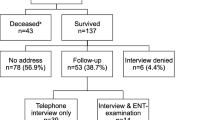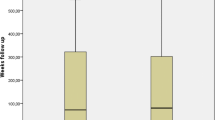Abstract
Objective
Percutaneous dilatational tracheostomy is increasingly practiced in intensive care units and has a low incidence of early complications. The late effects of this procedure are still poorly known and were the focus of this study.
Design
Prospective descriptive clinical study.
Setting
Interdisciplinary intensive care unit in a 300-bed teaching hospital.
Patients
A consecutive group of critically ill patients who underwent percutaneous tracheostomy between Nov. 90 and March 93, surviving at least 2 months after decannulation.
Measurements and results
There were 17 patients fulfilling the inclusion criteria and 16 of them were seen and examined. The follow-up protocol required a formal standar dized patient interview, a physical examination of the stoma site and a fiberoptic laryngotracheoscopy. Results of these sub-tests and overall outcome rating were standardized and expressed as good, moderate or poor. Subjective rating was good in all patients. All denied suffering from any side effects of their tracheostomy. Clinical examination revealed neither stridor nor hoarseness in any of the patients. Most of the scars were whitish and less than 1 cm in length, a few were sunken in, none had adhesions. In 15 patients the clinical result was good and in one, moderate (whitish, sunken-in scar, longer than 2 cm). Ten patients underwent tracheoscopy, while 6 did not. There were no signs of significant stenosis or tracheomalacia. In 8 patients with minor findings results were scored as good, while 2 were classified as moderate (combination of swelling and scar formation of a string-like membrane). The overall rating was good in 13 patients (81%) and moderate in 3 patients (19%). There were no poor outcomes.
Conclusions
Late outcome of percutaneous dilatational tracheostomy in critically ill patients is mostly good. Pending further studies, the use of this technique in intensive care units appears justified.
Similar content being viewed by others
References
Ciaglia P, Firsching R, Syniec C (1985) Elective percutaneous dilatational tracheostomy: a new simple bedside procedure; Preliminary report. Chest 87:715–719
Hazard P, Jones C, Benitone J (1991) Comparative clinical trial of standard operative tracheostomy with percutaneous tracheostomy. Crit Care Med 19:1018–1024
Schachner A, Ovil Y, Sidi J, Rogev M, Heilbronn, Levy MJ (1989) Percutaneous tracheostomy — a new method. Crit Care Med 17:1052–1056
Griggs WM, Worthley LIG, Gilligan JE, Thomas PD, Myburg JA (1990) A simple percutaneous tracheostomy technique. Surgey 170:543–545
Hazard PB, Garrett HE, Adams JW, Robbins ET, Aguillard RN (1988) Bedside percutaneous tracheostomy: experience with 55 elective procedures. Ann Thorac Surg 46:63–67
Worthley LIG, Holt A (1992) Percutaneous tracheostomy. Intensive Care World 9:187–192
Rohrer R, Reigner M, Frutiger A (1992) Die perkutane Dilatationstracheostomie nach Ciaglia: Eine zweckmäßige Alternative auf der Intensivstation? (abstract) Schweiz Med Wochenschr 122:784
Waldron J, Padgham ND, Hurley SE (1990) Complications of emergency and elective tracheostomy: a retrospective study of 150 consecutive cases. Ann R Coll Surg Engl 72:218–220
Griggs WM, Myborgh JA, Worthley LIG (1991) A prospective comparison of a percutaneous tracheostomy technique with standard surgical tracheostomy. Intensive Care Med 17:261–263
Ciaglia P, Graniero KD (1992) Percutaneous dilatational tracheostomy. Results and long-term follow-up. Chest 101:464–467
Lund T, Goodwin CW, McManus WF, Shirani KZ, Stallings RJ, Mason AD, Pruitt BA (1985) Upper airway sequelae in burn patients requiring endotracheal intubation of tracheostomy. Ann Surg 20:375–382
Stauffer AL, Olson DE, Petty TL (1981) Complications and consequences of endotracheal intubation and tracheotomy; a prospective study of 150 critically ill adult patients. Am J Med 70:65–76
Heffner JE (1991) Percutaneous tracheotomy — novel technique or technical novelty? Intensive Care Med 17: 252–253
Marelli D, Paul A, Manolidis S, Walsh G, Odim JNK, Burdon TA, Shennib H, Vestweber KH, Fleiszer DM, Mulder DS (1990) Endoscopic guided percutaneous tracheostomy: early results of a consecutive trial. J Trauma 30: 433–435
Nowak P, Cohn AM, Guidice MA (1987) Airway complications in patients with closed-head-injuries. Am J Otolaryngol 8:91–96
Paul A, Marelli D, Chiu RCJ, Vestweber KH, Mulder DS (1989) Percutaneous endoscopic tracheostomy. Ann Thorac Surg 47:314–5
Ciaglia P (1990) Letter to the Editor. J Trauma 30:1421
Quanjer PH (1983) Standardized lung function testing. Bull Eur Physiopath Resp 10:(suppl 5):1–118
Heffner JE, Miller KS, Sahn SA (1986) Tracheostomy in the intensive care unit. 1. Indications, technique, management. Chest 90:269–274
Gunawardana RH (1992) Experience with tracheostomy in medical intensive care patients. Postgrad Med J 68: 338–341
Webb Boyd S, Benzel EC (1992) The role of early tracheotomy in the management of the neurosurgical patient. Laryngoscope 102:559–563
Stock MC, Woodward CG, Shapiro BA, Cane RD, Lewis V, Pecaro B (1986) Perioperative complications of elective tracheostomy in critically ill patients. Crit Care Med 14:861–863
The International Advisory Committee of the EPIIC Study (1993) The EPIIC Study (European Prevalence of Infection in Intensive Care). Med Action Communications, London, UK
Viau F, Lededente A, Le Tinier JY (1988) Complications de la trachéotomie. Rev Pneumol Clin 44:24–32
Woo P, Kelly G, Kirshner P (1989) Airway complications in the head-injured. Laryngoscope 99:725–731
Wood DE, Mathisen DJ (1991) Late complications of tracheotomy. Clin Chest Med 12:597–609
Heffner JE, Miller KS, Sahn SA (1986) Tracheostomy in the intensive care unit. 2. Complications. Chest 90:430–436
Waldron J, Padgham ND, Hurley SE (1990) Complications of emergency and elective tracheostomy: a retrospective study of 150 consecutive cases. Ann R Coll Surg Engl 72:218–220
Hutchinson RC, Mitchell RD (1991) Life-threatening complications from percutaneous dilational tracheostomy. Crit Care Med 19:118–120
Friedman Y (1992) Percutaneous tracheotomy. (Letter) Laryngoscope 102: 954–956
Author information
Authors and Affiliations
Rights and permissions
About this article
Cite this article
Fischler, M.P., Cantieni, R., Frutiger, A. et al. Late outcome of percutaneous dilatational tracheostomy in intensive care patients. Intensive Care Med 21, 475–481 (1995). https://doi.org/10.1007/BF01706200
Received:
Accepted:
Issue Date:
DOI: https://doi.org/10.1007/BF01706200




